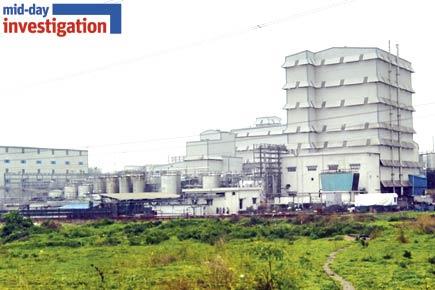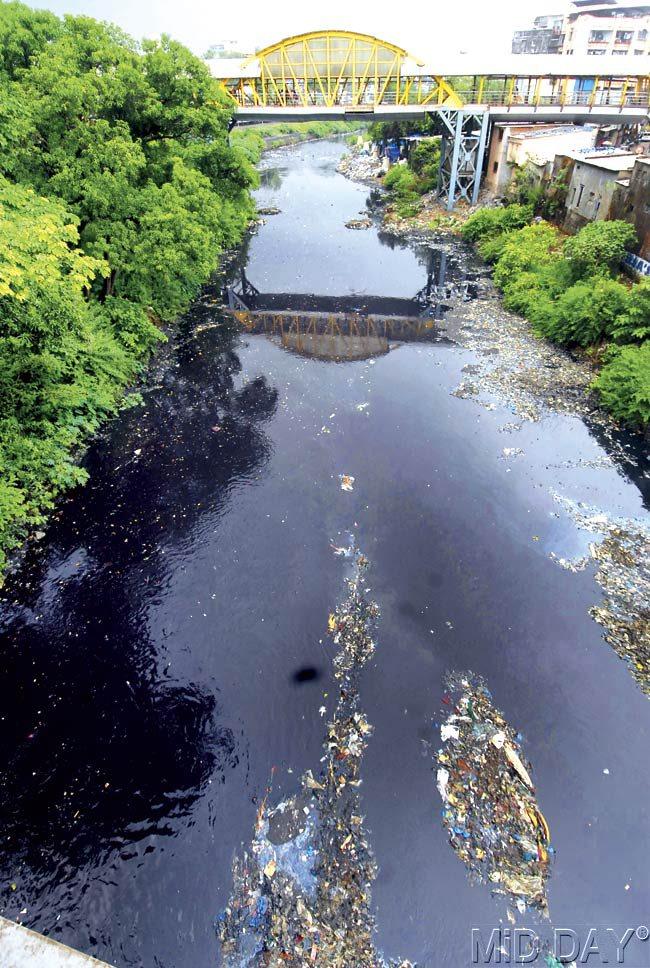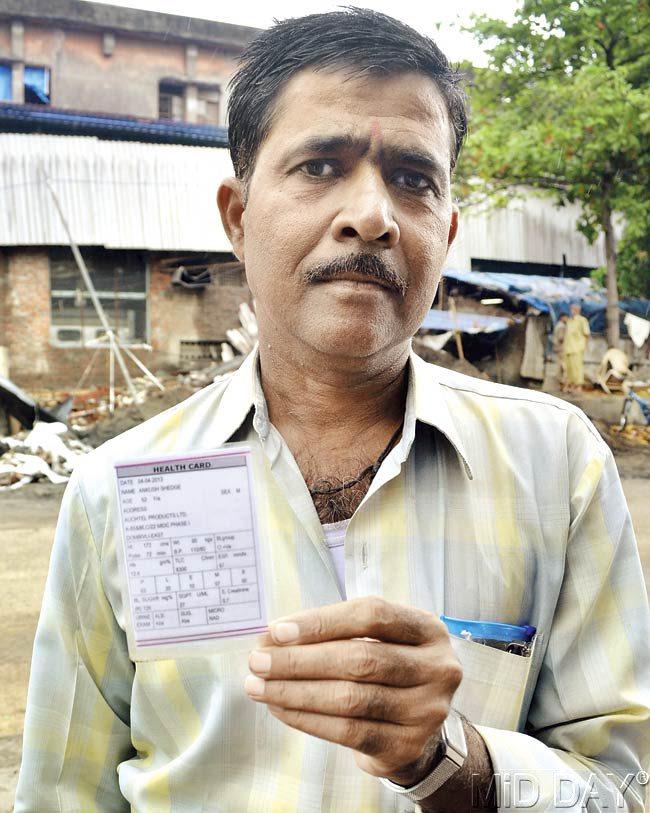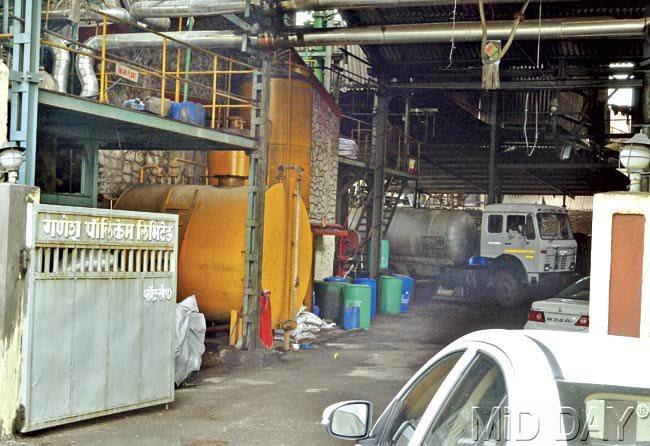Everything from detergent to popcorn is made in factories dotting the Mumbai Metropolitan Region that store tonnes of hazardous chemicals with scant regard for rules or safety of workers and public at large

While both the central and state governments have been spending billions to fight terrorism, nearly every nook and cranny of the Mumbai Metropolitan Region (MMR) has been filling up with ticking time bombs.
ADVERTISEMENT
Also read: They lied to me for 15 years of my life, says asbestosis-afflicted labourer

Many factories at Ambernath were found flouting norms. Pics/Sameer Markande
And while you may not even hear them explode, the consequences will be disastrous — everything from fires to poisonous substances spreading through air and water, causing cancer and DNA mutations in large swathes of the population.

This nullah near Ulhasnagar station seems to have become a river of chemicals and industrial waste
A mid-day investigation has revealed that hundreds of factories located across the city deal with tonnes of hazardous metals and chemicals on a daily basis, with little or no government oversight and hardly any safety measures in place.

Unmindful of the dangers posed by the nearly 20 tonnes of ethylene oxide in his Dombivli factory, labourer Ankush Shegde is grateful for the basic healthcare he gets. Pics/Datta Kumbhar
This paper has accessed the latest safety audit reports of 230 chemical and manufacturing units in Mumbai, Ulhasnagar, Kalyan, Dombivli, Vasai, Tarapur, Palghar, Pawane, Mahape, Turbhe and Bhiwandi, and found that most of them turn a blind eye to safety and health guidelines, rendering them vulnerable to accidents

A trader said every time he has gone inside Ganesh Polychem in Dombivli, he has wondered how the factory gets away with little or no safety precautions
Ironically, safety measures were found missing even in the 400-odd units dubbed Major Accident Hazard (MAH) sites — units identified as highly vulnerable to accidents as a result of the chemicals they store.
After Gujarat, which has 497 Major Accident Hazard units, Maharashtra, with 361, has the highest number in the country. Many of these are located in the periphery of Mumbai and deal with nearly 65 varieties of hazardous chemicals.
MAH units are governed by the stringent Control of Industrial Major Accident Hazards (CIMAH) rules and must anticipate dangers in advance, prepare on-site plans and conduct routine checks and mock-drills. But most MAH factories inspected in the Mumbai Metropolitan Region were found grossly deviating from the norms and approved plans.
A job turns deadly
While they labour hard to make products for your daily use — utensils, antibiotics, hand sanitisers, skin creams etc — lakhs of workers in the MMR are exposed every day to harmful chemicals, metals and minerals such as lead, aniline, benzene, cadmium, mercury, asbestos and silica.
Even as Maharashtra witnessed 199 fatal accidents last year in its 42,000 factories employing nearly 23 lakh workers, none of the units audited showed full compliance with, and more than half violated at least four or more aspects of, the Factories Act 1948.
Many of the violations involved a lack of safety measures and ensuring proper working conditions for the employees, alteration of the storage area for chemicals and illegal shuffling around of hazardous material without the state’s permission.
Ankush Shedge, a 52-year-old labourer at Auchtel Products Ltd, a textile and leather finishing unit in Dombivli is unmindful of the dangers posed by the deadly ethylene oxide used in the manufacturing process at his plant. Last year, four workers had died and several were injured in two explosions inside chemical plants in the vicinity.
“I take each day as it comes in these conditions,” he says, pointing towards the underground storage facility of the unit, where 20 metric tonnes of ethylene oxide is stored. Used in the production of detergents and thickeners among other things, ethylene oxide is poisonous, flammable, carcinogenic and mutagenic (can cause changes to the genetic material, usually DNA, of an organism). As a result, Shedge’s company is a classified MAH chemical plant.
His company, however, has no leak detection arrangements or self-contained breathing apparatus for the workers. “I know that no matter what I do, I cannot change the careless approach towards chemical hazards,” says Hegde, thanking his stars in the same breath that his company is at least providing some healthcare. “Lakhs of others just don’t get it,” he says.
“It is widely believed that once workers go to work at these chemical plants, they will last for three years. What happens after that is their fate,” said a trader from Kalbadevi, who deals in chemical products at Kalbadevi. “We just buy deadly chemicals such as titanium dioxide and acetic acid at Rs 140-Rs 150 per unit. There is little time to think about the workers who are handling them at the godowns and plants,” he adds nonchalantly.
Nexus
What’s more, mid-day’s investigation has revealed a nexus of private doctors, government inspectors and greedy owners, which is suppressing cases of occupational diseases prevalent amongst workers in industrial hubs of the state.
Out of the total 2,44,890 tests conducted by 105 private certified doctors between January 2013 and May 30, 2014, not a single occupational disease was reported. Files accessed under RTI by this newspaper show that the state’s Directorate of Industrial Safety & Health (DISH) is grossly inept at monitoring the chemical units as the health of the workers is compromised by the nexus.
Last year, 13 workers showing symptoms of Asbestosis and Silicosis in the MMR and areas of Raigad were shown tested negative by private doctors and the state government took action only after a central agency intervened. The nexus was exposed by a sudden visit by the expert panel of the National Institute of Occupational Health (NIOH), Ahmedabad, which found symptoms of occupational diseases in several factory workers on February 27, 2013. The government has now instituted an inquiry on a host of private certified doctors who did not report these cases to the state.
Dombivli
From the reports studied by mid-day, it appears that authorities and factory owners in Dombivli seem to have learnt no lessons from their hazardous history. In an audit of M/s Ganesh Polychem located in MIDC, inspectors noted non-compliance of suitable safety devices like temperature, pressure and vacuum monitors provided for chemical reactors.
The plant is a notified MAH unit as it stores methyl sulphate and methyl aniline. It also stores sulphur trioxide in two tanks weighing 19 metric tonnes (MT) and 36MT. On January 27, 2014, a government inspection found that the unit did not put together a document enlisting hazardous chemicals, as is mandatory under the rules, and did not bother to install splash guards for its corrosive pipelines, which carry chemicals.
Its inspection also found major sources of ignition left open near flammable chemicals.“Surfaces of overheated reactor shall be prevented in the factory while workers shall not be allowed to work without wearing protective equipment,” notes the inspection report of DISH Deputy Director V V Katamwar.
Even though cylinder and boiler blasts are common in Dombivli and have cost several workers their lives, when this reporter visited, he found workers at most factories without any protective gear. At Auchtel Products, inspectors noted lacunae in the handling of methyl chloride and issued instructions to ‘strictly comply’ with, and make arrangements for, methyl leak detection, absorption and neutralization at the site.
A methyl toner leak arresting kit and self-contained breathing apparatus were asked to be immediately provided. Inspectors also noted on January 28, 2014, that no hand gloves, masks, boots or other safety equipment were provided to workers at the site.
“None of the aspects were fully complied with. I noted these points and asked the owners to immediately act upon them,” Katamwar told mid-day. “Every time I have gone inside Ganesh Polychem, I’ve wondered how they get away with little or no safety provisions. The factory and the workers’ fate always hangs by a thread,” said a chemical trader who buys in bulk from the factory.
Vasai
In Vasai, 60 km away, the narrative does not change much. If anything, it gets grimmer. In chemical units, the latest inspections have found that most workers were asked to perform their duties near dangerous areas and on fragile roofs and ceilings.
An inspector told mid-day that factories in Vasai have no provision for hot air and fumes generated in their casting and furnace areas to be channelled out as they clustere together. As a result the fumes circulate inside the factories. “They also do not apply anti-rust paint on chemical receivers, condenser cooling coils, etc,” an inspector said.
The inspection of M/s Exon Enterprises found that the deadly chemical ethyl acetate was handled in storage areas with ordinary electrical fittings, causing a potentially dangerous situation. “We found that there were 12 tubelights and three electrical switchboards, which were not flameproof, around the chemical storage area,” he added.
The unit was also found to be manufacturing printing material using the highly inflammable ethyl acetate. “It is clear that the occupier is running the factory without complying with the conditions subject to which plans were approved. This is in contravention of rule 4(3) of the Factories Rules,” said the report of DISH Deputy Director S V Labhane.
Tarapur
Nine months after the rise in temperature inside a chemical tank led to blast at a drug manufacturing company, killing five workers on the spot, conditions have remained as unsafe as they were. When this reporter visited the area, he found drains carrying multi-coloured discharge from hundreds of units, with a smoky vapour emerging from it.
DISH inspector AD Khot found National Pharmaceutical operating without a licence and making illegal alterations to the work and storage area. “By using the premises as a factory without a licence, the occupier has contravened rule 4(4) of the Factories Rules,” he noted in the report.
At nine other pharma and medicare firms, his inspection found that boilers exceeding the approved capacity were installed and some did not have exhaust systems. At Shri Sai Industries in Tarapur he ‘threatened legal action’ as ammonia, hydrogen and nitrogen were used as raw material without crucial measures being taken.
Bhiwandi
This is the Wild West of all the chemical zones, and everything here, including electricity, is obtained in violation of rules. Chemical units here are mostly involved in textile and yarn dying work, which involves heavy use of hazardous chemicals.
When inspector B R Hirekar visited a unit on plot 6-8, Bhairav compound, he found that a tonne of acetic and hydrochloric acid was being handled manually by workers. Air compressors, pressure vessels and pipelines had not been tested by any auditors. “There is nothing legal about this area and it is one of the toughest zones to supervise,” said an official.
Senior government officials pointed out that inspections need to be more stringent to instil some fear in the mind of the factory owners. “The inspectors are just doing walk-in inspections hoping that the owners will not repeat their mistakes. They need to improve on this,” said DISH Director (Industrial safety and health) V S Moray.
 Subscribe today by clicking the link and stay updated with the latest news!" Click here!
Subscribe today by clicking the link and stay updated with the latest news!" Click here!






